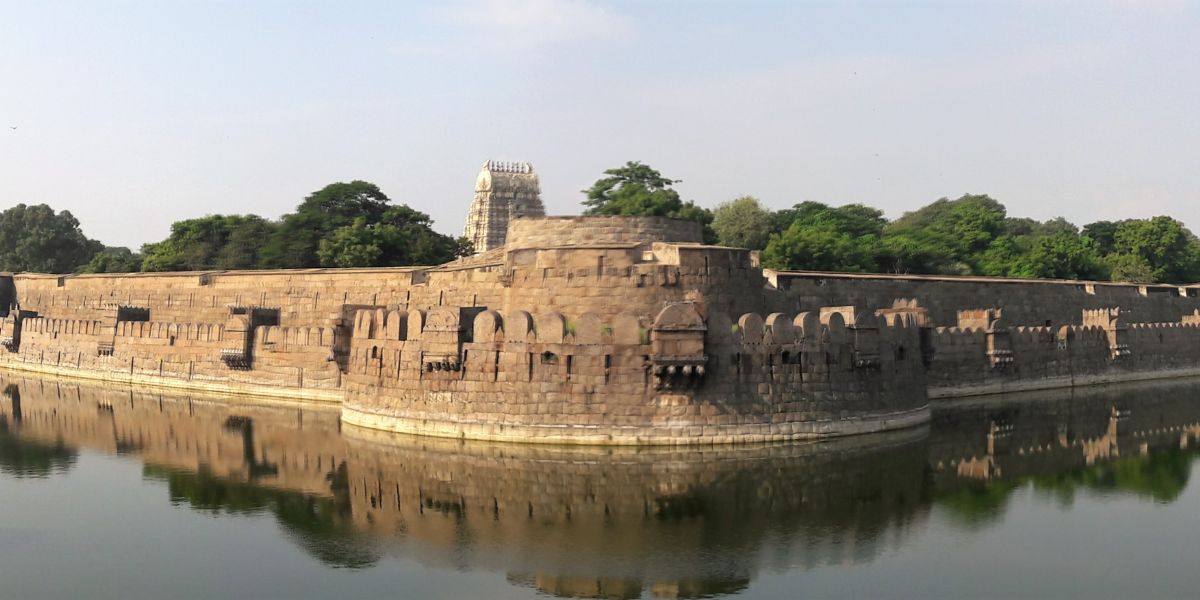The fortified walls of the 16th-century Vellore Fort have borne witness to centuries of history, standing resolute over time.

The Vellore Fort was constructed in the 16th century. (By Ssriram mt commons.wikimedia.org)
When discussing the freedom movement against British colonial rule, our minds often leap to the iconic revolt of 1857 in Meerut, hailed as the dawn of India’s struggle for independence. Yet, hidden in the annals of history lies a lesser-known precursor – the Vellore Sepoy Mutiny of 1806, a key event whose history still reverberates through Tamil Nadu’s Vellore district.
At the centre of this tale stands the Vellore Fort, witness to centuries of tumultuous history. Originally erected in 1566 by Chinna Bommi Nayak and Thimma Nayak, loyal chieftains under Emperor Sadasiva Raya of the Vijayanagara Empire, this fortress gained strategic prominence during the reign of the Aravidu Dynasty.
Over time, it passed from the hands of Vijayanagara emperors to Turko-Persian Bijapur sultans, Marathas, Carnatic Nawabs, and ultimately, the British, who held sway until India’s independence.
The Vellore Mutiny of 1806 took place within these storied walls, sparked by a decree from the British commander-in-chief of the Madras Army. His mandate, which prescribed replacing the turbans of Madras sepoys with round hats and demanding the removal of beards, caste markings, and jewellery, ignited a powder keg of religious and cultural indignation. This led to a fateful clash on July 10, 1806.
In the predawn hours, Indian sepoys stationed within the fort rose in rebellion, launching a daring assault on the European barracks. Though the mutiny was quelled within a day, its repercussions reverberated across the seas, shaking the very foundation of British authority. This marked a turning point in India’s colonial history.
Today, the Vellore Fort stands as a symbol of resilience. Its magnificent architecture is a blend of military prowess and cultural heritage.
With its grand ramparts, deep moats, and robust masonry, the fortress offers a glimpse into South India’s rich past, housing not only secular structures but also sacred sites like the Jalakandeswarar, St John’s Church, and Nawab Chanda Sahib Mosque. Visitors can marvel at the intricate carvings of the Jalakandeswarar Temple or explore history at the museum established within the fort’s walls.
Vellore Fort at sunset pic.twitter.com/0xNaRdWCBn
— Jennifer Howes (@jhowesuk) February 5, 2023
The Government Museum has a myriad of treasures spanning ancient to contemporary times, encompassing a vast array of subjects including anthropology, botany, geology, numismatics, pre-history, and zoology.
This fort also holds a significant place in history, having served as a place of captivity for notable figures such as Tipu Sultan’s family and Sri Vikrama Rajasinha, the last king of Sri Lanka. Additionally, the fort bears witness to the tragic massacre of Sriranga Raya’s family, the Vijayanagara royal family. Today, a memorial, known as Muthu Mandapam or Pearl Palace, surrounds the tombstone of Sri Vikrama Rajasinha.
Accessibility to Vellore is easy, whether by road, rail, or air.
Its prime location directly opposite the Old Bus Stand makes it accessible to visitors arriving by bus.
For travellers arriving by train, the nearest railway station is Vellore-Katpadi Junction, offering seamless connectivity to the fort and its surroundings.
This sculpture is
Scarved in
Vellore
Jalagandeeswara temple pic.twitter.com/TE3peuB1Qe— sIMSOn (@sIMSOn72344392) December 19, 2022
Situated approximately 211 km from Bengaluru and 140 km from Chennai, the city is well-connected via national highways. For those arriving by air, Chennai Airport serves as the nearest international gateway.
The Vellore Fort is open on all days from 8 am to 6 pm. It is located at Balaji Nagar, opposite the Old Bus Stand.
‘Southern Splendours’ is a heritage travel series that serves as your go-to guide for discovering the vibrant religious, historical, and cultural landmarks that dot the scenic landscapes of South India.

Jul 26, 2024

Jul 26, 2024

Jul 24, 2024

Jul 24, 2024

Jul 19, 2024

Jul 18, 2024